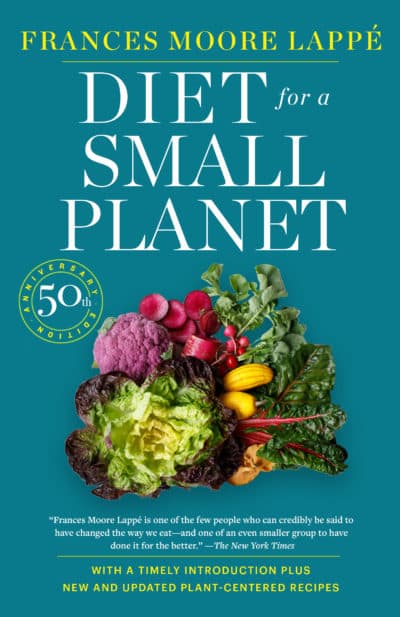Diet for a Small Planet Vegan or Vegetarian
Celebrating 50 years of 'Diet for a Small Planet' with Frances Moore Lappé and daughter Anna Lappé 10:53 Copy the code below to embed the WBUR audio player on your site
Copy the code below to embed the WBUR audio player on your site
Play

Vegetarian and vegan options are standard on restaurant menus these days. But that wasn't the case decades ago.
One book sits at the center of generational change in food and eating: Frances Moore Lappé's "Diet for a Small Planet." First published in 1971, the book argues that a plant-centered approach promotes healthy people and a healthier planet.
Since then, "Diet for a Small Planet" has sold 3.5 million copies and gone through 10th and 20th-anniversary editions. For the new 50th anniversary version, Moore Lappé's daughter, Anna Lappé, brought the original recipes into the 21st century.
For Moore Lappé, the recipes are central to the book.
"The book is an invitation to enjoy, to experiment, to be healthier, to really excite people about this way of eating," Moore Lappé says, "and not thinking of it as giving up, but as embracing."

The book includes tasty, filling recipes like Frankie's Feijoada, which Lappé only slightly tweaked. Some updated recipes now include butter instead of margarine or omit '70s ingredients like soy grits.
"A lot of the refresh of the recipes was really looking at all that we've learned about nutrition and plant-centered eating, and bringing in a lot more fresh ingredients," Lappé says.
The notion that people can't get enough protein from eating plant-based diets is a myth — one Lappé says her mother has battled for 50 years. Now, Lappé feels like more people understand that plant foods can provide ample protein.
Michael Pollan, the author of "The Omnivore's Dilemma," calls "Diet for a Small Planet" one of the most visionary books of the last 50 years. Many of these ideas went from counterculture in 1971 to mainstream in 2021.
In the original edition of the book, Moore Lappé argued that the food choices individuals and nations make — from how public money is invested to what celebrated chefs cook — have ramifications for individuals and the planet, her daughter says.
As time goes on, Lappé says more people understand Pollan's famous quote: "Eat food, mostly plants, not too much."
"What we eat is a political act," she says, "and these choices we make about our food as individuals and societies have such global implications."
The realization that she's not powerless woke Moore Lappé up, she says.
"I believe that every human being needs to feel that we have power, that we're not powerless, and that our acts have meaning and that we're connected to others in that meaning," she says. "What better way to experience that than through food?"
Moore Lappé says she was shocked when she first learned about "the incredible waste built into the grain-fed, meat-centric diet."
Livestock takes up 80% of the planet's agricultural land — but only accounts for 18% of the calories people consume. And in the Amazon rainforest, 80% of deforestation is due to livestock.
"This grain-fed, meat-centric diet was driven by this very simple mechanism of what I call a one rule marketplace that only returns wealth to the wealthy," Moore Lappé says. "And so it drove this system that made no sense in terms of our health or people being able to eat or maintaining the agricultural richness."
The decisions people make every day can help awaken others and start a conversation around these important issues, she says.
Americans can afford meat in a way many poor people around the world can't. But with consumers in the U.S. eating more meat per capita than any other country in the world, this unhealthy diet is "killing us," Moore Lappé says.
Indigenous diets, however, have focused on plants for generations. Moore Lappé encourages all Americans to value these traditions. And the combination of legumes and grains can be found throughout the world, she says.
Moore Lappé hopes that as Americans continue to amass wealth, the idea of meat consumption as a status simply will end. It's a necessary shift to decrease the up to 37% of greenhouse gas emissions that come from the food system, she says.
"I read this wonderful estimate in a peer-reviewed journal saying that as we turn to a plant-centered diet, it would be the equivalent of taking all the cars and trucks and even planes and boats out of the way in terms of saving greenhouse gas emissions," she says. "That's the kind of impact it could have."
For people starting to shift to a plant-based diet, Lappé recommends trying Anthony's Leek, Shiitake, and Miso Butter "Casserole" and Soy-Pickled Peppers. Her favorite recipe in the book, this pasta dish combines an unexpected array of flavors. And Moore Lappé says to try the Walnut Cheddar Loaf, which she fondly remembers cooking with her daughter for Thanksgiving when Lappé lived in Brooklyn.
Emiko Tamagawa produced and edited this interview for broadcast with Todd Mundt. Allison Hagan adapted it for the web.
Recipes from "Diet for a Small Planet"
Frankie's Feijoada
6 servings
This recipe was one of the favorites from the first edition, with updates from a Brazilian friend for the 20th anniversary edition.
- 1/4 cup oil for sautéing
- 1 large onion, chopped
- 2 cloves garlic, minced
- 2 scallions (white and light green parts), chopped
- 1 green bell pepper, seeded and chopped
- 1 tomato, chopped
- 3 cups cooked black beans, or two 15-ounce cans, rinsed and drained
- 2 cups vegetable stock
- 1 bay leaf
- 1 teaspoon white wine vinegar
- 2 stalks celery, chopped
- 1/2 sweet potato, diced (optional)
- 1 1/2 teaspoons salt
- Chopped fresh cilantro
- 1 sliced orange, for topping
Heat the oil in a large pot and sauté the onion, garlic, scallions, green pepper, and tomato until the onion is translucent. Add the beans, stock, bay leaf, vinegar, celery, sweet potato, and salt. Bring to a boil, reduce the heat, and simmer, covered, for 20 minutes.
Mash some of the beans in the pot to thicken the mixture and continue cooking for 5 more minutes. Remove the bay leaf and top with chopped cilantro and orange slices. Enjoy with rice and greens.
Anthony's Leek, Shiitake, and Miso Butter "Casserole" and Soy-Pickled Peppers
4 to 6 servings
This is a comfort food mash-up of Honk Kong noodles and leek chowder that plays to the strength of the angel hair-like pasta, fideo. The final result is a savory umami bomb. The Soy-Picked Serrano Peppers (recipe follows) provide a good counterpoint. If you're serving it with the peppers, start those pickling before you begin making the pasta dish. – Anthony Myint
- 1 medium leek
- 8 tablespoons (1 stick) unsalted butter, plus more for sauteing
- Salt
- 6 ounces shiitake mushrooms, or more if you want it more mushroomy (chanterelle and oyster are also good options)
- 2 shallots, peeled, halved lengthwise, and thinly sliced, for garnish
- 4 ounces Bloomsdale spinach or other sweet, tender green
- 2 tablespoons miso, light or dark are both fine; red miso is especially good here
- 1 cup half-and-half, plus more as needed
- 12 ounces fideo or angel hair pasta, broken into 1-inch pieces
- Chopped fresh cilantro for garnish
Clean the leek thoroughly and reserve the tough greens for stock or other use. Cut the tender interior lengthwise into quarters, then slice finely crosswise and place in a microwave-safe bowl. But the butter into small pieces, toss it with the leeks and a generous pinch of salt, microwave for 30 to 60 seconds until the butter is melted and the leeks are completely relaced. Add more time as needed. Meanwhile, bring a large pot of salted water to a boil.
Remove the shiitake stems. (You can reserve them for stock as well). Slice the shiitake caps into thin strips. Heat a large pan – large enough to eventually toss all the pasta – on medium-high heat, spoon 4 or more tablespoons of the butter from the melted leeks into the pan, and salt generously. Sauté the shiitakes until golden brown, about 6 minutes, tossing occasionally.
In a small pan, melt a bit more butter, about a tablespoon, and add the shallots, frying them until golden brown and crispy, 2 to 4 minutes. Set aside.
Wash, drain, and cut the spinach into ½ - ¼ inch-wide strips.
Add the leeks, butter, and miso to the large pan with the shiitakes and break up any miso clumps. Add the half-and-half and chopped spinach and simmer until spinach has just softened, 1 to 2 minutes. Turn off the heat.
Meanwhile, boil the pasta until just cooked, approximately 2 minutes. Drain, reserving about a half cup of the pasta water, add the pasta to the large pan, and toss and fold to incorporate. The result should be a slippery and savory pasta. Add salt to take and another generous splash of half-and-half or reserved pasta water right before serving to ensure slipperiness. Garnish with cilantro and the crispy shallots and serve with soy-pickled peppers.
Soy-Pickled Serrano Peppers
- 6 serrano peppers
- ¼ cup soy sauce or tamari
Halve the peppers lengthwise, remove the stem and seeds, and thinly slice them crosswise. In a small bowl, combine them with the soy sauce. These soy-picked peppers are a great complement to the mild leek pasta. They're also delicious atop tacos and sandwiches.
Walnut Cheddar Loaf
1 loaf, about 6 servings
This vegetarian version of meat loaf is especially nice served with whole walnuts sprinkled on top.
- 2 tablespoons oil
- 1 large onion, chopped
- 1 cup coarsely chopped walnuts
- 1 cup grated cheddar cheese
- Juice of ½ lemon
- 2 eggs, beaten
- ½ teaspoon salt
- 2 tablespoons nutritional yeast
- 1 teaspoon caraway seeds
- 1 ¼ cup cooked brown rice (1/2 cup uncooked)
Preheat the oven to 350F. Heat the oil in a pan and sauté the onion until translucent. Mix the onion with the remaining ingredients in a bowl and put the picture in an oiled 9 x 5 inch loaf pan, smoothing the top. Bake for 30 minutes, or until edges are browned. Allow to cool and cut into slices.
Diet for a Small Planet Vegan or Vegetarian
Source: https://www.wbur.org/hereandnow/2021/10/11/diet-for-a-small-planet